Burpees need no introduction. Most people know them as the exercise where the soul leaves the body for the duration of the set. For formality’s sake—burpees are four exercises squeezed into one—plank, push-up, squat, and jump.
The full-body functional exercise is anaerobic in itself. However, when done as part of a circuit or with rest durations between sets, it works as an aerobic exercise.
At this point, burpees are a part of most high-intensity circuit training routines.
What makes the burpees click
Burpees are a bodyweight, full-body exercise that can be done anywhere and require as much space as a push-up. Depending on your goal, you could vary your training intensity by rushing through the reps or going slow. Plus, did we mention burpees will smoke you in no time? Most people can only do 50 burpees before they throw in the towel.
If you’re reading this article, we assume you know burpees are good for you, but you want to get all the benefits they offer without undergoing the torture that comes with them. Burpee alternatives can be helpful for people dealing with injuries or restarting their fitness journey after an extended break.
Although this might be an unpopular opinion, burpees are not suitable for everyone. Folks on the heavier side might find it difficult to complete the push-up, squat thrust, and jump in a single exercise. Plus, burpees come with a learning curve, and alternate exercises can help build the strength and stamina required to master the explosive exercise.
Level Up Your Fitness: Join our 💪 strong community in Fitness Volt Newsletter. Get daily inspiration, expert-backed workouts, nutrition tips, the latest in strength sports, and the support you need to reach your goals. Subscribe for free!
There is another group that generally maintains its distance from the HIIT exercise—bodybuilders. Here are things you should never ask a bodybuilder:
- How many burpees can you do?
- Let’s do a burpee face-off.
- Worst of all—Do you even burpee, bro?
For a serious bodybuilder, burpees are synonymous with satan, and most bodybuilders, especially in the bulking phase, avoid this exercise.
Trivia: Royal H. Burpee created the original burpee exercise, a much more low-impact version of what is used today during his Ph.D. candidacy. The exercise was supposed to be used as a fitness test.
How To Perform a Burpee
Before we get into the alternatives to burpees, it’s important to learn the correct form of performing the exercise as it will give us a better idea of exercises that can replicate different parts of the movement.
Here is how to perform a burpee:
- Start in a squat position with your knees bent and back straight. Keep your feet wide as you’ll be placing your hands inside your feet in the next step.
- As you lower into a squat, extend your arms towards the floor and place them inside your feet.
- Transfer your weight to your hands and kick back your legs so you are in a push-up position.
- While keeping your body in a straight line from head to toe, perform a push-up.
- Perform a frog kick so your feet are under your hips.
- Stand and reach your arms over your head.
- Jump as high as possible.
- Have a soft landing, get back into a squat, and repeat for reps.
Pro Tips:
- While lowering into a squat, bring your heels off the floor. Doing so will get you in position for a reverse squat thrust as soon as your hands hit the floor.
- Keep your torso upright at the bottom of the squat before jumping your feet back into the push-up position. Hunching your back will put more pressure on your spine.
- Do not let your midriff dip or lift your hips during the push-up as it takes away the tension from your core.
13 Best Burpee Alternatives
Here are the 13 alternatives to burpees you should try if you cannot do the OG high-intensity exercise:
1. Murpees
Mobility burpees, or murpees, are a low-impact version of the burpees.
Here is how to perform a murpee:
- Slowly lower yourself into a squat while raising your heels off the floor.
- Step back with one leg at a time to get into a push-up position.
- Bring one leg forward so that the knee is touching the elbow. Follow suit with the other leg.
- Place your feet flat on the floor and take your hands off the floor. You will find yourself in a squat in this position.
- Return to the starting position by extending at your knees and pushing through your heels.
- Slowly raise your arms at your sides and touch them overhead.
- As your arms return to your sides, lower yourself into a squat and repeat for recommended reps.
Pro Tips:
- You could perform a jump after returning to the starting position to bump up your training intensity.
- Get more out of this exercise by increasing the time under tension by slowing your rep tempo.
2. Jump Squat
Jump squat is one of the most basic yet hard exercises on the list. Plus, you could target different areas of your upper legs in this exercise by changing your foot placement.
Here is how to perform a jump squat:
- Stand with your feet shoulder-width apart.
- Bend at your knees and descend into a deep squat. Go as low as possible without bending your back.
- Brace your core, engage your quads, glutes, and hamstrings, and push yourself up through your heels.
- As you reach the top of the squat, use momentum to jump off the floor.
- Control your landing and descend into a squat.
- Repeat for recommended reps.
Pro Tips:
- If you’re new to this exercise, you should do it on a soft surface like an exercise mat or grass. Avoid performing the jump squat on concrete as it can hurt your joints.
- Use your arms to generate more power for the jump by swinging them through the range of motion.
Check out the complete jump squat guide here!
3. Explosive Push-up
If you’re dealing with a lower-body injury or want to add an explosive upper-body movement to your exercise arsenal, you cannot go wrong with the explosive push-up.
Here is how to perform an explosive push-up:
- Get into a push-up position so that your hands are directly under your shoulders.
- Slowly lower yourself towards the floor until your chest is a few inches off the floor.
- Extend your arms explosively so that your hands are no longer touching the floor. Your goal should be to push yourself high enough to clap your hands in the air.
- Land on your hands and slowly lower yourself into a push-up.
- Repeat for recommended reps.
Pro Tips:
- Make sure your body is in a straight line throughout the movement.
- You don’t have to push your body so hard that you’re in the air for a long time. The airtime should be just enough to clap your hands once.
Check out the 15 intense push-up variations
4. Jumping Jack
The jumping jack is one of the most popular aerobic exercises. While most of us learn to perform this low-impact exercise in school, it is lost in the vast abyss of more advanced exercises.
Here is how to perform a jumping jack:
- Stand upright with your legs together and arms at your sides.
- Bend your knees slightly, and jump into the air.
- As you jump, spread your legs to be about shoulder-width apart. Stretch your arms out and over your head.
- Jump back to starting position.
- Repeat.
Pro Tips:
- As you get more advanced, you could perform this exercise while holding a dumbbell in each hand.
5. 4-Count
The four-count or four-count burpee is a stripped-down (low-impact) version of the conventional burpee.
Level Up Your Fitness: Join our 💪 strong community in Fitness Volt Newsletter. Get daily inspiration, expert-backed workouts, nutrition tips, the latest in strength sports, and the support you need to reach your goals. Subscribe for free!
Here is how to perform a 4-count:
- Slowly lower yourself into a squat while raising your heels off the floor.
- Place your hands in front of your feet and transfer your weight to your arms.
- Jump back into a plank position.
- Frog jump so your feet are under your hips. Return to the starting position.
- Repeat for recommended reps.
6. Pike Plank Jump
This exercise is a variation of the conventional pike planks, where your feet are on the floor throughout the exercise.
Here is how to perform a pike plank jump:
- Start in a push-up position. Your body should be in a straight line at this position.
- Frog jump and bring your feet towards your chest while lifting your hips towards the ceiling.
- Your legs will remain extended throughout the exercise, and your torso and head will be in a straight line.
- Return to the starting position.
- Repeat for reps.
Pro Tips:
- Many people make the mistake of raising their hips before frog jumping into a pike.
- Keep your shoulders pulled back throughout the exercise.
- Make sure you’re on your toes throughout the movement.
7. Plyo Lunge
This exercise is known by various names, including the alternating split squat jump and the Russian lunge—you know things are getting serious when the Russians are involved.
Here is how to perform a plyo lunge:
- Stand upright with your feet shoulder-width apart.
- Jump and come into a lunge position with your left leg forward.
- Your left upper leg should be parallel to the floor and the right knee a few inches off the floor.
- Jump and switch legs.
- Alternate between legs for recommended reps.
Pro Tips:
- Performing slow and controlled reps might help you find balance.
- Make sure your rear knee is close to the floor at the bottom. Do not jump to switch legs just for the sake of it.
8. Mountain Climber
The mountain climber is a cult favorite. The high-intensity exercise helps build a shredded core and can improve your cardiovascular strength, endurance, and stamina.
Here is how to perform a mountain climber:
- Get into a push-up position. Your hands should be shoulder-width apart, back flat, and abs engaged.
- Pull your right knee into your chest as far as possible.
- Switch legs, pulling one knee out and bringing the other knee in as far and as fast as possible.
Pro Tips:
- Keep your hips down throughout the movement. Elevating your hips takes off tension from your core.
- Beginners can perform this exercise in a low-plank position as it puts less tension on the shoulders and core.
Check out the complete mountain climber guide here!
9. High Knees
This is probably the most basic exercise on the list. However, you’ll be begging for mercy after a few sets. High knees are a popular warm-up exercise in sports, and you’ll usually see athletes perform this exercise before any strenuous physical activity.
Here is how to perform high knees:
- Stand upright with your feet shoulder-width apart and your arms at your sides.
- Begin the exercise by bringing your right knee toward your chest, slightly above waist level. Simultaneously, move your left hand up in a pumping motion.
- Quickly lower your right leg and left hand.
- Repeat with your left leg and right hand.
- Alternate between your right and left leg for the desired time or reps.
Pro Tips:
- If you are new to this exercise, starting slow will help maintain balance.
- If you can’t bring your knee above waist level, you should stop the set and begin after adequate rest.
Check out the complete high knees guide here!
10. Kettlebell Swing
While all exercises up until now were body weight, the following exercises require training equipment. The kettlebell swing is one of the most popular kettlebell exercises. When performed correctly, kettlebell swings build total-body strength, power, and balance, while improving cardiovascular stamina.
Here is how to perform the kettlebell swing:
- Stand upright with a wider-than shoulder-width stance while holding a kettlebell with both hands between your legs.
- Keep your arms loose and maintain a slight bend in your elbows while squeezing your shoulder blades together and engaging your core.
- Soften your knees, shift your weight into your heels, and lower your hips back and down.
- Driving through your heels, explode through your hips to send the weight swinging upward from your quads. Aim for chest height, with your arms extended.
- Contract your core and glutes at the top.
- Shift your weight back into your heels while hinging at your hips.
- Allow the kettlebell to ride back between your legs.
- Repeat for recommended reps.
Pro Tips:
- While performing the kettlebell swing, focus on lifting the barbell with your legs and not your arms.
- The hip thrust to return to the upright position is arguably the most important part of the lift.
Check out the complete kettlebell swing guide here!
11. Medicine Ball Slam
You will love the medicine ball slam if you’re a fan of burpees because they give you a solid abdomen workout.
Here is how to perform the medicine ball slam:
- Stand with your knees slightly bent while holding a medicine ball above your head with your arms extended.
- Push your hips back, contract your core, and slam the medicine ball with all your might against the floor about a foot in front of you.
- Catch the ball on its way back up.
- Repeat for recommended reps.
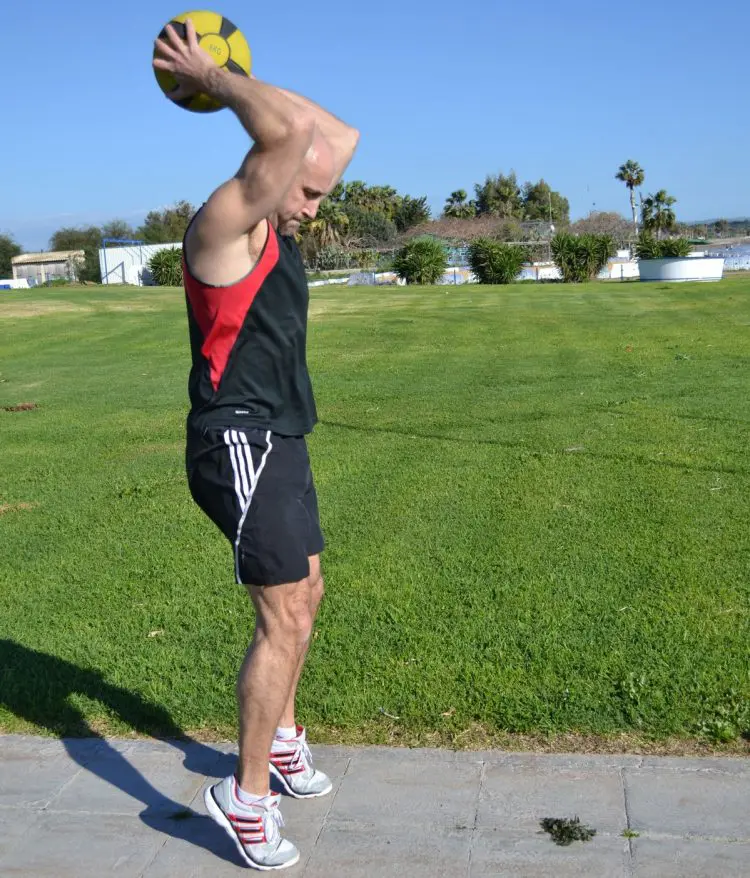
Pro Tips:
- Let your arms follow through so you don’t lose your balance and fall forward.
- You should be on your toes at the top of the movement.
12. Jump Rope
Jump rope is incredibly effective at burning calories and working your cardiovascular system.
Here is how to perform jump rope:
- Stand upright with a shoulder-wide stand while holding a jump rope handle in each hand.
- Extend your hands and forearms at least a foot away from your body, at a 45-degree angle.
- Get into the starting position by stepping over the rope. The rope should hang behind you so that the middle of the rope hits the back of your feet.
- Use your hands and wrists to swing the rope over your head.
- Hop over the rope when it comes close to your feet.
- Find a rhythm.
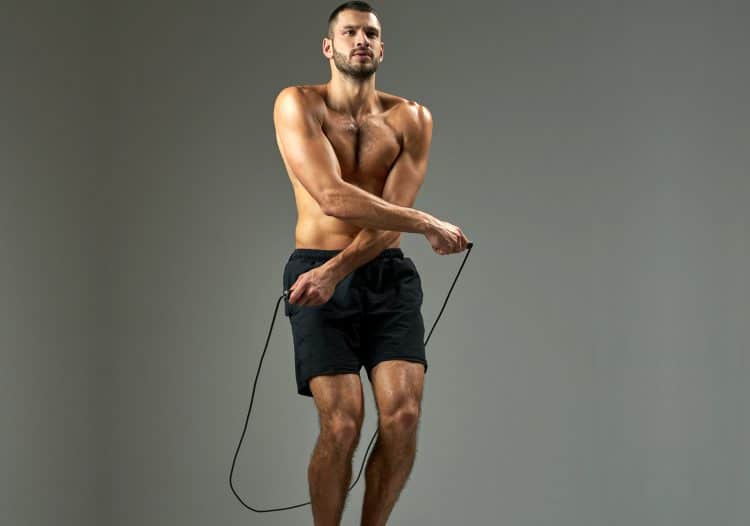
Pro Tips:
- Don’t move your arms to swing the rope. Keep the motion limited to your wrists.
- Remain on your toes throughout the exercise.
- You might need some practice before you find your pace and master this exercise.
Check out the complete jump rope guide here!
13. Dumbbell Thruster
The dumbbell thruster can help strengthen your core and stabilizers. This exercise is a hit amongst the CrossFit community.
Here is how to perform thrusters:
- Stand upright with your feet shoulder-width apart and engage your core while holding a dumbbell in each hand.
- Stack the weights on your shoulders.
- Slowly lower into a half squat by pushing your hips down and back.
- Return to the starting position explosively while simultaneously pushing the weights overhead.
- Lower the dumbbells back to your shoulders.
- Repeat for recommended reps.
Pro Tips:
- Working on your upper body mobility can make the dumbbell stacking position more comfortable.
- Keep your torso upright while lowering into a squat.
More Alternative Exercises:
- Alternatives to the Must-Do Exercises
- Great Alternatives to Dips
- Best Box Jump Alternatives For Building Explosive Strength
- Best Back Extension Alternatives
- Best Romanian Deadlift (RDL) Alternatives
- Best Pull Up Alternatives and Variations For All Fitness Levels
- Hyperextension Alternatives for A Powerful Posterior Chain
Wrapping Up
Burpees are one of the most effective high-intensity exercises. However, you might not be able to perform them due to an injury or mobility issues.
In this article, we have put together 13 comparatively lower-impact exercises to help you achieve similar muscular and cardiovascular benefits as burpees. We hope you find the ones that work the best for you. Best of luck!
Interested in measuring your progress? Check out our strength standards for Deadlift, Squat Thrust, Mountain Climbers, and more.

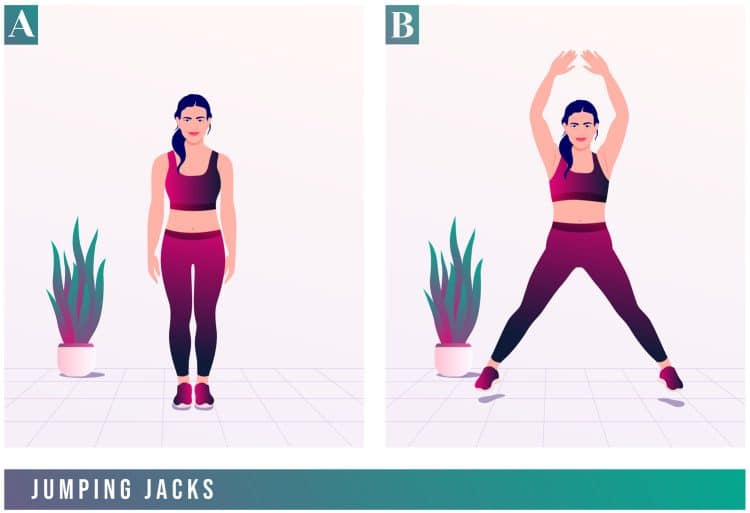

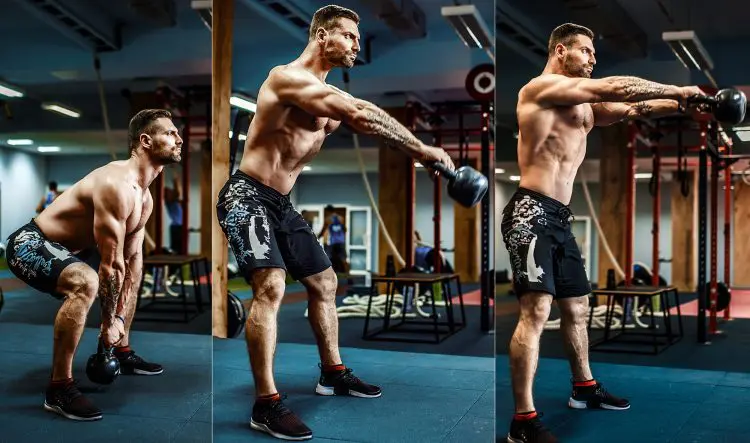





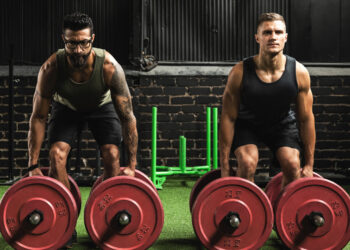


Good stuff! but, if you have to raise your heels during burpees or the mobility version, it’s a sign you’ve got tight calves. In fact, the video demo of the mobility one says to keep your heels down, and not rise onto your toes.